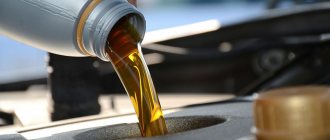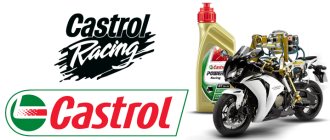Motor oil for motorcycles is an indispensable structural component of the working process of gasoline engines. The reliable operation of internal combustion engine components and parts throughout its entire service life depends on the technologically correct selection of lubricants.
If you have decided to purchase an iron horse and are in the search stage, professionals specializing in the sale of motorcycles in Moscow and the region will help you with this.
Now let’s talk about what types of motorcycle oil there are and the general requirements for them.
Types of oils
Oil for an internal combustion engine consists of two main components - a base (base raw material) and modifying additives. The technical characteristics of oil compositions largely depend on the properties of the base compositions.
Chemical additives serve only to regulate and improve certain operational parameters.
Based on the production method, the basic components are divided into several categories:
- Mineral oils obtained by processing and subsequent rectification of petroleum products.
- Synthetic – products of the synthesis of hydrocarbon compounds (producer gas, etc.).
- Semi-synthetic - basic modifications made from synthetic (25%) and mineral raw materials.
The chemical structure of a mineral resource is based on the primary quality of the oil, how it is distilled, and the level of filtration. The mineral base component is the cheapest product for processing petroleum feedstock.
It is characterized by variable viscosity, unstable temperature parameters, low resistance to oxidative processes and high volatility.
Synthetic oil has stable viscosity properties and a lower pour point compared to a mineral base, which makes starting the engine much easier in winter.
The oil film formed on the surface of the mechanism parts is not destroyed when the engine operates at extreme turbo modes.
Semi-synthetic is a chemical composition containing 20–40% synthetic base oil in its structure. There are no standards or recommendations for the percentage of components in the solution.
In terms of performance characteristics, these liquids occupy an intermediate level between synthetic and mineral compounds. The price of semi-synthetic products is almost half that of synthetics.
How much oil to pour into gasoline - rules for preparing the mixture
Having figured out how much oil to pour into gasoline, you can start preparing the fuel mixture. To do this, you will need a clean metal or plastic canister. First, the required amount of gasoline is poured, and then lubricating fluid is added in the required volume. After completing the dilution, tilt the canister a couple of times.
As a result of repeated shaking, the liquids are mixed, and the prepared fuel acquires a uniform color. Depending on the color of the oil added, the finished liquid may be greenish, bluish or reddish.
When performing work, safety precautions and fire regulations must be observed. Mixing work must be carried out in a ventilated area, or even better, in outdoor conditions. Smoking is not allowed when working with flammable liquids. Mixing must be done with gloves to protect the skin from contact with aggressive liquids.
The fuel container is filled with the prepared mixture and the gas tank cap is tightly closed. Gasoline mixed with oil can be stored in tightly closed cans. Gasoline mixed with oil retains its properties for a month.
That is why mixing should be done immediately before pouring, taking into account the frequency of use of the scooter or motorcycle.
Choosing motorcycle oil, tips and tricks
In the domestic automobile market there are many types of motorcycle oils in different price categories. Synthetics are more expensive, mineral water is cheaper. Recently, they have even begun to produce ready-to-use lubricants - diluted according to the standards and in the appropriate dosage.
How to choose the right modification. First of all, you need to use only the oil for your motorcycle that is indicated in the unit’s passport. The use of lubricants not specified in the maintenance instructions is strictly prohibited.
All motorcycle manufacturers must indicate the type of recommended oil in the accompanying documents. Markings may also be present on service stickers or on the drain plug in the engine crankcase.
Measuring containers
To maintain the correct proportion of gasoline and oil, a calculation table applied to the saw body can be used. Branded containers of leading motor oil manufacturers are equipped with built-in measuring devices that provide accurate dosage of oil for different volumes of the fuel mixture.
Measuring utensils are included in the factory kit of many budget chainsaw models. In some cases, a medical syringe with a volume of 20 cm3 will help to dilute gasoline with oil in a given proportion.
Advantages of synthetic motor lubricants
Expensive semi-synthetic or synthetic oils are in all respects preferable to cheaper mineral oils.
The cost of high-quality lubricant is compensated many times over:
- trouble-free operation of components and systems;
- stable traction characteristics of the power drive;
- reduction in costs for scheduled repairs;
- increased resource duration.
( 2 ratings, average 4.5 out of 5 )
Classification of oils
The most common certification system for liquid lubricants is the American SAE structure. According to the standards of this organization, the viscosity of lubricants is indicated by relative parameters that reflect the conditional value of the viscosity characteristics.
The larger the number at the beginning of the marking (5 or 25W), the better the viscosity of the product.
There are three main groups of lubricants:
- summer;
- winter;
- all-season.
Using a motorcycle in winter is very rare, however, oils from this group are present on the market in large quantities. The marking, which includes the English symbol W (“winter”), belongs to winter types of oils (for example, 15W40). The number after the letter indicates the degree of viscosity of the liquid.
Summer motorcycle lubricant is not particularly popular. They are designated SAE 20–40. The numbers 50, 60 units (only in designations for summer brands) belong to transmission compositions and are not used in engines.
All-season lubricants are lubricants obtained by adding improving modifying additives to their composition. This production technology allows you to start and operate a motorcycle engine in any temperature conditions.
For example, SAE 10W50:
SAE is a mandatory letter abbreviation for all-season oils;
10 – temperature limit below which the oil freezes;
50 – viscosity level;
W – indicates the possibility of using the product in winter.
For four-stroke and two-stroke engines, the indices 4T and 2T are added to the main product designation, respectively. Mixing and replacing these types of oils with each other is strictly prohibited.
Motorcycle oil viscosity and other quality indicators
Viscosity is the most important indicator influencing the choice and quality of petroleum products. This parameter may change its value if operating temperature conditions change.
To successfully start a cold engine at low temperatures, the viscosity coefficient must be within limits that ensure free rotation of the crankshaft and easy supply of oil fluid through the channels of the engine lubrication system.
Under extreme operating conditions, on the contrary, the mixture must have a high index, otherwise it will not be able to form a durable protective coating between the contacting surfaces, and also create the required pressure in the system.
Viscosity Index Characteristics
This is a value that shows the effect of engine temperature on the viscosity of oils. Digital index indicators are relative values. The higher the number, the higher the temperature limit of the liquid used.
For mineral varieties, without improving additives, the index value is 80–100. Lubricants with viscosity modifiers and synthetic components are in the range of 125–150 units. For deeply purified materials, the coefficient can rise to 200.
Flash point
This parameter characterizes the presence of low-boiling components in the lubricating composition; its value affects the volatility of the product during operation. For benign materials, this indicator ranges from 210–225°C.
In low-quality oils, mixtures with reduced viscosity quickly burn and evaporate, which causes increased resource consumption and a decrease in its temperature characteristics.
Pour point
This is an indicator that regulates the degree of mobility of the oil fluid. The setting temperature is characterized by a rapid increase in viscosity and the release of crystallized paraffin from homogeneous mixtures.
At the end of this process, the oil becomes hard and unable to perform any functions.
Base number
TBN or alkaline coefficient shows the ability of the oil used to neutralize acidic components formed during engine operation. The alkaline index for gasoline engines is 8–9 units.
Over time, during operation, the neutralizing components lose their properties. Violation of the oil change schedule can lead to contamination of the internal surfaces of the unit and acid corrosion of the metal.
Signs of misuse
Using a dirty or disproportionate mixture can cause serious engine problems. If you make a mistake when mixing, it’s okay, because the car itself will tell you about it. You just need to be attentive to some signs, including:
- The appearance of dirt and various deposits on the carburetor.
- Rapid contamination of the fuel filter located in the gas tank.
- Oxidation of the carburetor walls and loss of elasticity of the rubber diaphragm in various parts of the gas tank. This symptom appears only when the unsuitable mixture is stored for a long time directly in the gas tank of the car.
What do you need to know?
Choosing the right ratio for fuel mass is not a simple task. It is necessary to calculate the mixing proportions in accordance with the established norm. Sometimes drivers add ingredients at their own discretion. At the same time, disciplined vehicle owners who are concerned about the engine know that the recommended ratio is 1 to 50. How much oil is this? You will find the answer to this question below.
To mix ingredients you need to follow simple rules. To dilute gasoline with oil 1 to 50, it is recommended to use A-92 fuel. A-80 is often used, explaining this effect by the presence of a large number of additives in its composition. This is fundamentally wrong.
Oil from almost any production is suitable for mixing with fuel. The main thing is that it belongs to the auto group, and is not intended for tractors or motor boats. This oil should not be used. Otherwise, it will clearly shorten the life of the engine.
Formation of tarry deposits in the carburetor area.
At the slightest manifestation of one of the signs, it is necessary to make changes to the mixing process, choosing more suitable proportions. This way you can select the ideal fuel mixture and avoid serious problems with the engine.
To independently prepare the correct fuel mixture, which will ensure ideal engine performance, you must use the appropriate fuel, strictly adhere to the proportions specified by the manufacturer, use a suitable container and store the finished mixture for no longer than 30 days. By following these rules, you will prepare the ideal mixture for your car's engine.










